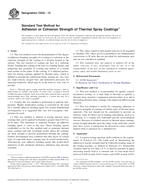We need your consent to use the individual data so that you can see information about your interests, among other things. Click "OK" to give your consent.
ASTM C633-13
Standard Test Method for Adhesion or Cohesion Strength of Thermal Spray Coatings
STANDARD published on 1.12.2013
The information about the standard:
Designation standards: ASTM C633-13
Note: WITHDRAWN
Publication date standards: 1.12.2013
SKU: NS-14341
The number of pages: 8
Approximate weight : 24 g (0.05 lbs)
Country: American technical standard
Category: Technical standards ASTM
The category - similar standards:
Annotation of standard text ASTM C633-13 :
Keywords:
adhesion strength, cohesion strength, fracture locus, thermal spray coatings, ICS Number Code 25.220.40 (Metallic coatings)
Additional information
| Significance and Use | ||
|
3.1 This test method is recommended for quality control, acceptance testing; or it may help to develop or qualify a thermal spray operator's equipment and procedure or to aid in developing thermal spray coatings with improved adhesion and integrity. 3.2 This test method is useful for comparing adhesion or cohesion strengths of coatings of similar types of thermal spray materials. The test should not be considered to provide an intrinsic value for direct use in making calculations, such as to determine if a coating will withstand specific environmental stresses. Because of residual stresses in thermal spray coatings, actual strength depends upon the shape of the particular coated part. Also, in use, a coating may be stressed in a more complex manner than is practical for a standard test. |
||
| 1. Scope | ||
|
1.1 This test method covers the determination of the degree of adhesion (bonding strength) of a coating to a substrate or the cohesion strength of the coating in a tension normal to the surface. The test consists of coating one face of a substrate fixture, bonding this coating to the face of a loading fixture, and subjecting this assembly of coating and fixtures to a tensile load normal to the plane of the coating. It is adapted particularly for testing coatings applied by thermal spray, which is defined to include the combustion flame, plasma arc, two-wire arc, high-velocity oxygen fuel, and detonation processes for spraying feedstock, which may be in the form of, wire, rod, or powder. 1.2 Usually this test method is
performed at ambient temperature. Higher temperature testing is
restricted by the need for a suitable adhesive bonding agent. For
certain fundamental investigations, it is suggested that very low
(cryogenic) temperature be used.
1.3 This test method is limited to testing thermal spray coatings that can be applied in thickness greater than 0.015 in. (0.38 mm). The limitation is imposed because an adhesive bonding agent is used in the test. Those bonding agents established so far for this method tend to penetrate thermal spray coatings and may invalidate results unless the coatings are thick enough to prevent penetration through the coating. Further development may establish that thin layers of certain types of especially dense coatings may be tested satisfactorily. Alternatively, new adhesive bonding agents that would allow reduction of the minimum thickness limitation may become available. 1.4 The values stated in inch-pound units are to be regarded as standard. The values given in parentheses are mathematical conversions to SI units that are provided for information only and are not considered standard. 1.5 This standard does not purport to address all of the safety concerns, if any, associated with its use. It is the responsibility of the user of this standard to establish appropriate safety and health limitations prior to use. |
||
| 2. Referenced Documents | ||
|
Similar standards:
Historical
15.5.2013
Historical
1.9.2014
Historical
1.11.2010
Historical
1.12.2013
Historical
1.11.2010
Historical
1.9.2009
We recommend:
Technical standards updating
Do you want to make sure you use only the valid technical standards?
We can offer you a solution which will provide you a monthly overview concerning the updating of standards which you use.
Would you like to know more? Look at this page.



 ASTM B633-13
ASTM B633-13 ASTM B634-14
ASTM B634-14 ASTM B636-84(2010)..
ASTM B636-84(2010).. ASTM B650-95(2013)..
ASTM B650-95(2013).. ASTM B651-83(2010)..
ASTM B651-83(2010).. ASTM B679-98(2009)..
ASTM B679-98(2009)..
 Cookies
Cookies
